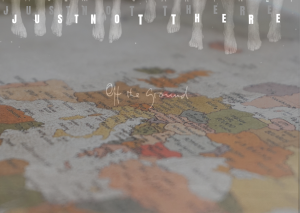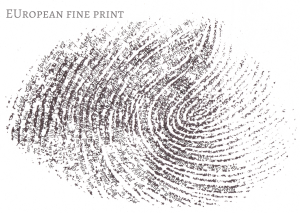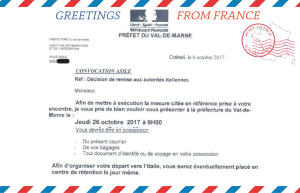Postcard 1

the map – unreachable ground. photo: student’s production. cover: Paul McCartneyOff The Ground℗.
Following the idea propagated by the dominant world map, one is “in” a country as one sets foot on that very physical ground. This assumption, however, brushes over the fact that much more than just physical territory, those borders demarcate distinct lived realities within them.
Upon their arrival in Europe, hoping to seek asylum in a safe space, refugees face multidimensional European border control that bars access to fully “being” in Europe legally, socially and experientially, more than merely physically.
In the process, they are continuously kept at a distance from the imagined safe haven Europe, and, unable to truly touch ground, safe refuge hence gets pushed into becoming a fading dream.
Postcard 2

EUropean fine print. Fingerprint credit: Lisa Vaas. Naked security blog.
Upon any contact with police or border control authorities in Europe, refugees have to have their fingerprints taken. As a major method of tracking migrants’ movements within European borders, fingerprints serve as a way to imprint state and border control onto their bodies.
While Europe propagates the idea of freedom of movement, its legal mechanisms to control refugee movements work diametrically differently and turn national borders into insurmountable obstacles.
EUropean fine print then mocks the European self-image of a humanitarian, superior and highly cultured place as it plays on ways in which EU policy can work against fundamental human rights. Human beings are pushed into legal “contracts” whose conditions they cannot influence, read or delete but that are written onto their bodies.
The materiality and making of this postcard traces the process of inscribing borders onto refugees’ hands: Written in ink on physical paper are pieces of information national authorities are able gain access to by “reading” refugees fingerprints. I used a scanner in order to digitize the “finger” on paper as would be the case when fed into a database.
Postcard 3

Greetings from France. Document source: article by Antoine.decourcelle.
Visuals: Canva
Greetings from France is an inverted postcard. While one usually sends postcards from a place one visits to another, to friends or family, this “postcard” is sent by the French state to an asylum seeker to inform them of their deportation and leaves no way of responding. Above is a collage of the parts of a so-called “décision de transfert” or “transfer decision” that refugees receive upon a host country’s decision that their stay is no longer legitimate according to the Dublin Convention (major framework that regulates refugee movement and allocation in Europe).
The text reads as follows:
“Asylum citation. Concerning: decision about return to Italian authorities. Sir, in order to execute the measure referenced above, you are asked to present yourself at the police headquarters of Val-de-Marne on: …. You have to have with you: this letter, all your belongings, any identification document you own. In order to set up your leave to Italy, you will be put into a retention center on the day of your appointment.” (own translation)
Playing on the absurdity of such a letter, I use the airpost letter frame as a reference to deportation by plane and the colors of the French tricolor as turning national pride into national defense.
